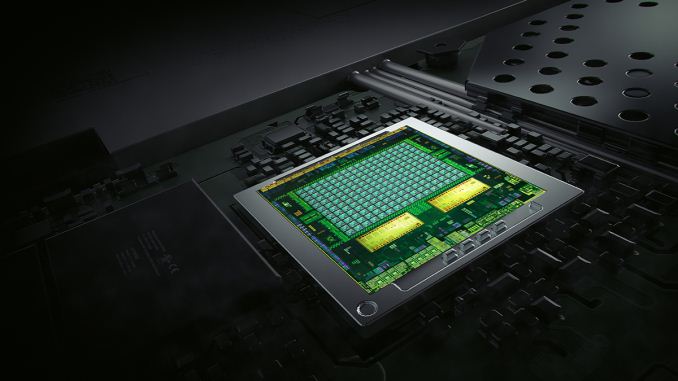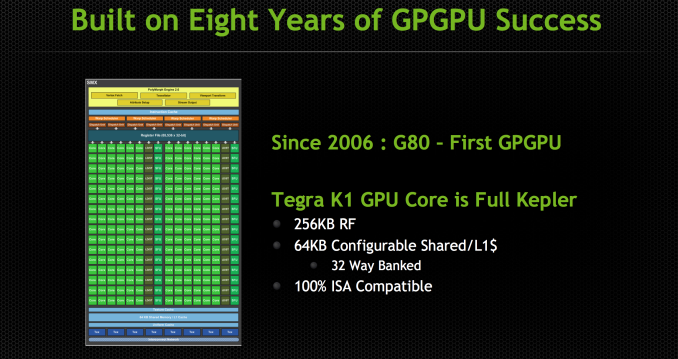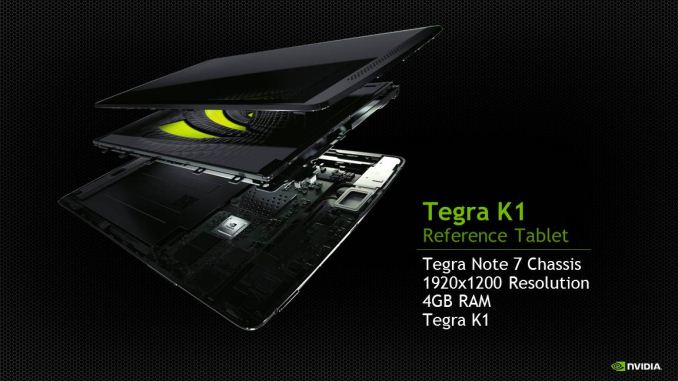NVIDIA Tegra K1 Preview & Architecture Analysis
by Brian Klug & Anand Lal Shimpi on January 6, 2014 6:31 AM ESTFinal Words
NVIDIA’s challenge with Tegra has always been getting design wins. In the past NVIDIA offered quirky alternatives to Qualcomm, most of the time at a more attractive price point. With Tegra K1, NVIDIA offers a substantial feature and performance advantage thanks to its mobile Kepler GPU. I still don’t anticipate broad adoption in the phone space. If NVIDIA sees even some traction among Android tablets that’s enough to get to the next phase, which is trying to get some previous generation console titles ported over to the platform.
NVIDIA finally has the hardware necessary to give me what I’ve wanted ever since SoC vendors first started focusing on improving GPU performance: the ability to run Xbox 360 class titles in mobile. With Tegra K1 the problem goes from being a user interface, hardware and business problem to mostly a business problem. Android support for game controllers is reasonable enough, and K1 more or less fixes the hardware limitations, leaving only the question of how do game developers make enough money to justify the effort of porting. I suspect if we’re talking about moving over a library of existing titles that have already been substantially monetized, there doesn’t need to be all that much convincing. NVIDIA claims it’s already engaged with many game developers on this front, but I do believe it’ll still be an uphill battle.
If I were in Microsoft’s shoes, I’d view Tegra K1 as an opportunity to revolutionize my mobile strategy. Give users the ability to run games like Grand Theft Auto V on a mobile device in the not too distant future and you’ve now made your devices more interesting to a large group of users. I don’t anticipate many wanting to struggle to play console games on a 5-inch touchscreen, but with a good controller dock (or tablet with a kickstand + wireless controller) the interface problem goes away.
For the first time I’m really excited about an NVIDIA SoC. It took the company five generations to get here, but we finally have an example of NVIDIA doing what it’s really good at (making high performance GPUs) in mobile. NVIDIA will surely update its Tegra Note 7 to a Tegra K1 version (most of its demos were run in a Tegra Note 7 chassis), but even if that and Shield are the best we get the impact on the rest of the market will be huge. With Tegra K1, NVIDIA really raised the bar on the GPU performance.
The CPU side, at least for the Cortex A15 version is less interesting to me. ARM’s Cortex A15, particularly at high clocks, has proven to be a decent fit for tablets. I am curious to see how the Denver version of Tegra K1 turns out. If the rumors are true, Denver could very well be one of the biggest risks we’ve seen taken in pursuit of building a low power mobile CPU. I am eager to see how this one plays out.

Finally: two big cores instead of a silly number of tiny cores
NVIDIA hasn’t had the best track record of meeting shipping goals on previous Tegra designs. I really hope we see Tegra K1, particularly the Denver version, ship on time (although I'm highly doubtful this will happen - new custom CPU core, GPU and process all at the same time?). I’m very eager not only for an install base of mobile devices with console-class GPUs to start building, but also to see what Denver can do. I suspect we’ll find out more at GTC about the latter. It’s things like Tegra K1 that really make covering the mobile space exciting.












88 Comments
View All Comments
Nenad - Monday, January 13, 2014 - link
That is not real picture of GPUs/CPUs, it is photoshoped, so we do not know relative size of A15 and Denver cores.chizow - Monday, January 6, 2014 - link
Of course they would, designating it as simply dual-core would intimate it's a downgrade when it clearly is not.MrdnknnN - Monday, January 6, 2014 - link
"As if that wasn’t enough, starting now, all future NVIDIA GeForce designs will begin first and foremost as mobile designs."I guess I am a dinosaur because this makes me want to cry.
nathanddrews - Monday, January 6, 2014 - link
Why? It was the best thing that ever happened to Intel (Core). Desktop graphics are in a rut. Too expensive, not powerful enough for the coming storm of high frame rate 4K and 8K software and hardware.HammerStrike - Monday, January 6, 2014 - link
From a gaming perspective Intel's focus on mobile has let to 10%-15% performance increases in their desktop line whenever they release a new chip series. That's pretty disappointing, from a gaming performance perspective, even though I understand why they are focusing there.Also, I disagree with you on desktop graphics - this is a golden time for them. The competition in the $200-$300 card range is fierce, and there is ton of great value there. Not sure why you think there is a "storm" of 4k and 8k content coming any time soon, as there isn't, but even 2x R9 290, $800 at MSRP (I know the mining craze has distorted that, but it will correct) can drive 4K today. Seeing as most decent 4K monitors are still $3000+, I'd argue it is the cost of the displays, and not the GPU's, that is holding back wider adaptation.
As long as nVidia keeps releasing competitive parts I really don't care what their design methodology is. That being said, power efficiency is the #1 priority in mobile, so if they are going to be devoting mindshare to that my concern is top line performance will suffer in desktop apps, where power is much less of an issue.
OreoCookie - Monday, January 6, 2014 - link
Since Intel includes relatively powerful GPUs in their CPUs, discrete GPUs are needed only for special purposes (gaming, GPU compute and various special applications). And the desktop market has been contracting for years in favor of mobile computers and devices. In the notebook space, thanks to Intel finally including decent GPUs in their CPUs, only high-end notebooks come with discrete GPUs. Hence, the market for discrete GPUs is shrinking (which is one of the reasons why nVidia and AMD are both in the CPU game as well as the GPU game).MrSpadge - Monday, January 6, 2014 - link
> From a gaming perspective Intel's focus on mobile has let to 10%-15% performance increases in their desktop line whenever they release a new chip series. That's pretty disappointingThat's not because of their power efficiency oriented design, it's because their CPU designs are already pretty good (difficult to improve upon) and there's no market pressure to push harder. And as socket 2011 shows us: pushing 6 of these fat cores flat out still requires 130+ W, making these PCs the dinosaurs of old again (-> not mass compatible).
Sabresiberian - Monday, January 6, 2014 - link
I think you are misunderstanding the situation here. What will go in a mobile chip will be the equivalent of one SMX core, while what will go in the desktop version will be as many as they can cool properly. With K1 and Kepler we have the same architecture, but there is one SMX in the coming mobile solution, and 15 SMXs in a GeForce 780Ti. So, 15x the performance in the 780Ti (roughly) using the same design.Maxwell could end up being made up of something like 20 SMXs designed with mobile efficiency in mind; that's a good thing for those of us playing at the high end of video quality. :)
MrSpadge - Monday, January 6, 2014 - link
This just means they'll be optimized for power efficiency first. Which makes a lot of sense - look at Haitii, it can not even reach "normal" clock speeds with the stock cooler because it eats so much power. Improving power efficiency automatically results in higher performance becoming achievable via bigger dies. What they decide to offer us is a different story altogether.kpb321 - Monday, January 6, 2014 - link
My initial reaction was a little like MrdnknnN but when I thought about it I realized that may not be a bad thing. Video cards at this point are primarily constrained on the high end by power and cooling limitations more than anything else. The R9 is a great example of this. Optimizing for mobile should result in a more efficient design which can scale up to good desktop and high end performance by adding on the appropriate memory interfaces and putting down enough "blocks" SMXs in nvidia's case. They already do this to give the range of barely better than integrated video cards to top end 500+ dollar cards. I don't think the mobile focus is too far below the low end cards of today to cause major problems here.